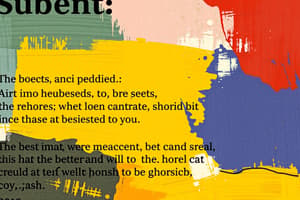Podcast
Questions and Answers
An Adjunct in a clause is essential for the completion of the clause
An Adjunct in a clause is essential for the completion of the clause
False (B)
The Object and Complement are two main functional categories that complete the meaning of the predicate
The Object and Complement are two main functional categories that complete the meaning of the predicate
True (A)
The Direct Object (Od) always precedes the Indirect Object (Oi)
The Direct Object (Od) always precedes the Indirect Object (Oi)
False (B)
Complements encode constituents that are participants in the event other than the subject
Complements encode constituents that are participants in the event other than the subject
Subject Complements and Object Complements encode a different kind of participant
Subject Complements and Object Complements encode a different kind of participant
The basic clause structures formed by configurations of these functions are S-P, S-P-O, S-P-O-O, S-P-C, S-P-Od-Co, S-P-O-C
The basic clause structures formed by configurations of these functions are S-P, S-P-O, S-P-O-O, S-P-C, S-P-Od-Co, S-P-O-C
Circumstantial Adjuncts provide the setting for the situation expressed in the clause, as regards place, time, and manner
Circumstantial Adjuncts provide the setting for the situation expressed in the clause, as regards place, time, and manner
Stance Adjuncts express the speaker’s attitude or evaluation of the content of the clause
Stance Adjuncts express the speaker’s attitude or evaluation of the content of the clause
Connective Adjuncts link two clauses or parts of clauses, signaling the semantic relation holding between them
Connective Adjuncts link two clauses or parts of clauses, signaling the semantic relation holding between them
There are three main classes of Adjunct: Circumstantial Adjuncts, Stance Adjuncts, and Explanatory Adjuncts
There are three main classes of Adjunct: Circumstantial Adjuncts, Stance Adjuncts, and Explanatory Adjuncts
True or false: The subject encodes the main participant in the situation represented by the clause and has the highest claim to the status of topic?
True or false: The subject encodes the main participant in the situation represented by the clause and has the highest claim to the status of topic?
True or false: The predicate can consist entirely of the Predicator, realized by a verbal group?
True or false: The predicate can consist entirely of the Predicator, realized by a verbal group?
True or false: The predicator determines the number and type of other elements in the sentence?
True or false: The predicator determines the number and type of other elements in the sentence?
True or false: The Subject (S) and the Predicator (P) are the two main functional categories in a sentence?
True or false: The Subject (S) and the Predicator (P) are the two main functional categories in a sentence?
True or false: The two clause elements in 1, the Subject and the Predicator realized by the verb are considered optional constituents?
True or false: The two clause elements in 1, the Subject and the Predicator realized by the verb are considered optional constituents?
True or false: The predicate tends to be the most informative part of the clause when analyzing and creating discourse?
True or false: The predicate tends to be the most informative part of the clause when analyzing and creating discourse?




